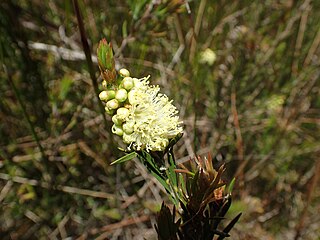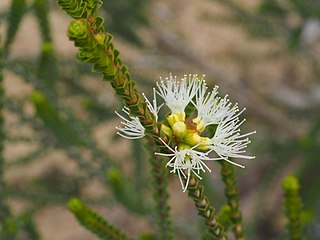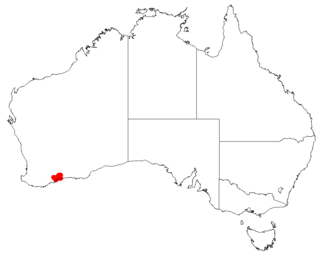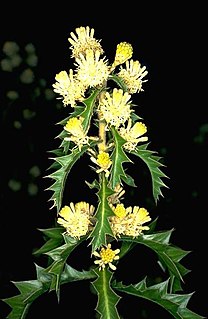
Grevillea armigera, also known as prickly toothbrushes or thorny grevillea, is a species of flowering plant in the family Proteaceae and is endemic to the south-west of Western Australia. It is an erect to spreading shrub with deeply-lobed leaves, the lobes linear and sharply pointed, and grey, green or pale yellow flowers with black to maroon styles.

Grevillea asparagoides is a species of flowering plant in the family Proteaceae and is endemic to the south-west of Western Australia. It is dense, prickly shrub with deeply divided leaves, the end lobes linear and sharply pointed, and pink to reddish flowers with red styles.

Sambucus gaudichaudiana, commonly known as white elderberry, is a species of flowering plant in the family Adoxaceae and is endemic to eastern Australia. It is a perennial shrub but with stems that are produced annually with pinnate leaves that have three to eleven leaflets, small white flowers and small but edible fruit. It grows in cool forest and shady gorges.

Melaleuca paludicola, commonly known as river bottlebrush, is a plant in the myrtle family Myrtaceae, and is endemic to eastern Australia. It is a shrub or small tree with flexible, often drooping branches, pinkish new growth and spikes of cream, pale yellow, or sometimes pink flowers in summer.

Actinotus minor, commonly known as the lesser flannel flower, is species of flowering plant in the family Apiaceae and is endemic to New South Wales. It is a small, sprawling plant with grey-green leaves and white flowers.

Eucalyptus ligustrina, commonly known as the privet-leaved stringybark, is a species of shrub, mallee or small tree that is endemic to New South Wales. It has rough, stringy bark, lance-shaped to egg-shaped adult leaves, flower buds in groups of between seven and fifteen, white flowers and hemispherical or shortened spherical fruit.

Baeckea brevifolia is a species of flowering plant in the family Myrtaceae and is endemic to south-eastern New South Wales. It is a shrub with narrow egg-shaped to oblong leaves and white to pink flowers with nine to fifteen stamens.

Beaufortia sprengelioides is a plant in the myrtle family, Myrtaceae and is endemic to the south-west of Western Australia. It is a rigid, spreading shrub with crowded, round leaves and small, roughly spherical heads of pale pink flowers on the ends of its branches. It was one of the first Australian plant species collected by Europeans and has had several name changes since then.

Persoonia dillwynioides, commonly known as Fitzgerald persoonia, is a species of flowering plant in the family Proteaceae and is endemic to a restricted area in the south-west of Western Australia. It is an erect, spreading shrub with smooth bark, linear leaves and bright yellow flowers borne singly or in groups of up to four along a rachis up to 3 mm (0.12 in) long.

Petrophile carduacea is a species of flowering plant in the family Proteaceae and is endemic to southwestern Western Australia. It is a shrub with deeply toothed leaves, and more or less spherical heads of hairy yellow flowers.
Isopogon villosus is a species of flowering plant in the family Proteaceae and is endemic to southwestern Western Australia. It is a tufted shrub with cylindrical leaves with twenty-five to thirty-two widely diverging lobes, and oval heads of cream-coloured to yellow flowers.

Tremandra stelligera is a flowering plant in the family Elaeocarpaceae. It is a small upright shrub with pink, purple or blue flowers, dark green oval shaped leaves and is endemic to Western Australia.

Philotheca myoporoides subsp. myoporoides, commonly known as long-leaf wax flower, is a subspecies of flowering plant in the family Rutaceae and is endemic to south-eastern continental Australia. It is a shrub with oblong to elliptic or egg-shaped leaves and white or pink flowers arranged in groups of three to eight in leaf axils.
Teucrium sessiliflorum, commonly known as camel bush, is a species of flowering plant in the family Lamiaceae and is endemic to southern continental Australia. It is a tufted perennial herb with hairy, egg-shaped, lobed leaves and white or cream-coloured flowers.

Dillwynia rudis is a species of flowering plant in the family Fabaceae and is endemic to eastern New South Wales. It is an erect shrub with warty, linear leaves and yellow to orange flowers with red veins.

Pultenaea capitellata, commonly known as hard-head bush-pea, is a species of flowering plant in the family Fabaceae and is endemic to south-eastern continental Australia. It is a sprawling to prostrate shrub with elliptic to broadly egg-shaped leaves, and yellow to orange flowers with a red to purple keel.

Pultenaea euchila, commonly known as orange pultenaea, is a species of flowering plant in the family Fabaceae and is endemic to eastern Australia. It is an erect shrub with glabrous foliage, narrow egg-shaped leaves with the narrower end towards the base, and orange-coloured flowers arranged singly or in small groups near the ends of branchlets.

Bossiaea lenticularis is a species of flowering plant in the family Fabaceae and is endemic to eastern New South Wales. It is a slender, spreading shrub with mostly circular leaves, and yellow and red flowers.

Podolobium scandens, commonly known as netted shaggy-pea, is a flowering plant in the family Fabaceae and is endemic to eastern Australia. It is a prostrate, small shrub with orange-yellow pea-like flowers and red markings.

Gompholobium virgatum, commonly known as leafy wedge pea, is a species of flowering plant in the family Fabaceae and is endemic to eastern Australia. It is a erect or sprawling shrub with trifoliate leaves, the leaflets narrow egg-shaped with the narrower end towards the base, and yellow and greenish, pea-like flowers.


















